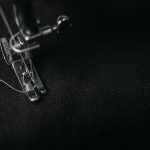When sewing with gauze, don’t pick the wrong type—lighter gauze tears easily, while stiff gauze won’t drape well. Always pre-wash to avoid shrinking or color bleeding. Pay close attention to fabric grain to prevent stretching and distortion. Use a fine needle and lightweight thread, and pin carefully to avoid holes. Finish seams properly to stop fraying and keep your iron heat low to protect delicate fibers. Stick with these tips, and you’ll craft flawless gauze projects with ease.
Table of Contents
Key Takeaways
- Avoid using heavy needles or thick thread; opt for fine needles (size 60/8 or 70/10) and lightweight thread to prevent fabric damage.
- Do not skip pre-washing gauze fabric to prevent shrinkage, color bleeding, and puckered stitches in the finished project.
- Always align pattern pieces with the fabric’s lengthwise grain to maintain stability and avoid distortion or uneven stretching.
- Use fine pins inserted perpendicular to seam lines and space them evenly to prevent fabric shifting and snagging.
- Finish seams properly with techniques like French seams or binding to prevent fraying and ensure garment durability.
Choosing the Wrong Type of Gauze
When you choose the wrong type of gauze, your sewing project can quickly become frustrating.
Picking the wrong gauze can turn your sewing project into a frustrating experience.
Gauze comes in different weights and weaves, and picking one that’s too sheer or too stiff can make your work harder. If the fabric is too delicate, it might tear or bunch as you sew. On the other hand, a heavier gauze mightn’t drape well, ruining your garment’s flow.
You’ll want to match the gauze’s texture and weight to your project—lighter gauze suits airy scarves or baby clothes, while sturdier options work better for home décor or structured pieces.
Always check the fabric’s feel and stretch before starting. Choosing the right gauze means smoother sewing and a more professional finish.
Skipping Fabric Pre-Washing
Although it might seem like an extra step, skipping fabric pre-washing can cause big problems down the line. When you skip this, your gauze may shrink or distort after the first wash, ruining your carefully sewn garment’s fit and shape.
Pre-washing removes sizing, dirt, and chemicals, guaranteeing the fabric behaves as it will in everyday wear. If you don’t pre-wash, your stitches can become uneven or puckered once the fabric shrinks, and colors might bleed or fade unpredictably.
Always wash and dry your gauze the same way you plan to care for the finished item. This simple step saves you from frustration and guarantees your project holds up beautifully after washing.
Don’t skip this essential preparation for successful sewing with gauze.
Ignoring Fabric Grain Direction
Pre-washing your gauze sets a solid foundation, but paying attention to the fabric’s grain direction keeps your project looking professional and guarantees proper fit.
When you ignore the grain, your garment can stretch unevenly or hang awkwardly. Gauze is lightweight and drapes differently depending on how it’s cut.
Align your pattern pieces with the fabric’s lengthwise grain, which runs parallel to the selvage, to maintain stability and shape. Cutting across the grain can cause distortion and puckering during sewing.
Take the time to identify the grain before cutting, even if it means rearranging your pattern pieces. This simple step assures your finished piece holds its form, fits correctly, and looks polished, preventing frustration and wasted fabric down the line.
Using Incorrect Needle and Thread
Choosing the right needle and thread is essential for sewing gauze successfully. Using the wrong tools can cause snags, puckers, or weak seams. To avoid these issues:
The right needle and thread prevent snags, puckers, and weak seams when sewing delicate gauze fabric.
- Use a fine, sharp needle like a size 70/10 or 60/8 to prevent damaging the delicate fabric.
- Choose lightweight polyester or cotton thread that matches the fabric’s weight and texture.
- Avoid heavy or thick threads which can create bulky seams and distort the gauze.
- Test your needle and thread on a scrap piece before starting your project to guarantee smooth stitching.
Neglecting Proper Pinning Techniques
You need to use fine pins when working with gauze to prevent snagging or holes.
Placing your pins carefully helps keep the fabric aligned without causing damage.
If you skip these steps, your delicate gauze can easily get ruined before you even sew.
Importance of Fine Pins
A set of fine pins can make all the difference when working with delicate gauze fabric. Using bulky or dull pins can easily damage the fabric, causing snags or permanent holes. When you choose fine pins, you guarantee that your fabric stays intact and your project looks professional.
Here’s why fine pins matter:
- They minimize fabric distortion by slipping through threads gently.
- They prevent visible holes, preserving the fabric’s delicate appearance.
- They allow precise alignment without shifting layers.
- They reduce the risk of fabric tearing during pinning or sewing.
Pin Placement Strategies
Fine pins help protect gauze fabric, but how you place them also plays a big role in keeping your project neat and intact. When pinning gauze, always insert pins perpendicular to the seam line rather than parallel. This approach holds layers securely without shifting and makes removing pins easier as you sew.
Space pins evenly, about every two to three inches, to avoid fabric bunching or slipping. Avoid pinning too close to the edge, which can distort the delicate fabric. Also, use pins with small, sharp heads to prevent snagging.
Proper pin placement guarantees your gauze stays aligned and smooth, reducing the chance of uneven seams. Remember, thoughtful pinning isn’t just about holding fabric—it’s about preserving your project’s clean, professional finish.
Avoiding Fabric Damage
Though pins seem like a small detail, neglecting proper pinning techniques can easily damage delicate gauze fabric.
To protect your fabric and guarantee smooth sewing, you need to handle pinning carefully. Here’s how you can avoid fabric damage:
- Use fine, sharp pins designed for lightweight fabrics to prevent snags.
- Insert pins perpendicular to the seam to reduce stress on the fabric.
- Pin within the seam allowance, so holes won’t show on the finished piece.
- Remove pins as you sew to avoid creating permanent holes or tears.
Sewing Without Stabilizing the Fabric
When sewing with gauze, you can’t skip stabilizing the fabric or you’ll risk distortion and uneven seams.
Using fabric stabilizers or temporary supports keeps your project in shape and easier to handle.
Let’s look at some simple techniques to keep your gauze steady as you sew.
Importance of Fabric Stabilizers
If you skip using fabric stabilizers while sewing with gauze, you risk stretching and distorting the delicate material.
Gauze’s loose weave makes it prone to shifting, which can ruin your project’s shape and fit. Fabric stabilizers provide the necessary support to keep gauze steady and manageable.
Here’s why you should always use them:
- Prevent fabric puckering and uneven seams.
- Maintain the fabric’s original texture and drape.
- Avoid thread breakage caused by fabric movement.
- Achieve precise stitching and clean edges.
Techniques for Temporary Support
Using fabric stabilizers offers great benefits, but sometimes you might need to sew gauze without them. When that happens, try using temporary support techniques like basting stitches or water-soluble spray adhesives. Basting helps hold fabric layers together without permanent marks, giving you control as you sew.
You can also use tissue paper underneath the gauze to prevent shifting; it tears away easily after stitching. Another trick is pinning carefully with fine, sharp pins to avoid snagging or distorting the delicate fabric.
Press your seams gently with a cool iron to set stitches without crushing the gauze’s texture. These methods let you work with gauze’s natural softness while maintaining precision, so you avoid common pitfalls even without stabilizers.
Preventing Fabric Distortion
Although gauze’s airy texture makes it prone to distortion, you can keep your fabric stable by handling it with care and using specific sewing techniques.
Without proper stabilization, your gauze may stretch, shift, or warp, ruining your project’s shape. To prevent this, try these tips:
- Use a lightweight stabilizer or tissue paper beneath the fabric while sewing to reduce shifting.
- Pin generously and evenly to secure layers without puckering.
- Sew slowly and gently, avoiding pulling or stretching the fabric.
- Opt for a smaller needle and shorter stitch length to maintain fabric integrity.
Overlooking Seam Finishing Methods
Because gauze is lightweight and prone to fraying, you can’t skip proper seam finishing methods without risking a messy, unraveling garment. Finishing seams neatly guarantees your project holds up through wear and washing. Don’t overlook options like French seams or binding edges—they prevent threads from coming loose and keep your garment looking polished.
| Feeling | Cause | Result |
|---|---|---|
| Frustrated | Unfinished seams fraying | Garment falls apart quickly |
| Confident | Using French seams | Durable, neat edges |
| Proud | Binding raw edges | Professional finish |
| Annoyed | Ignoring seam finishing | Constant repairs needed |
| Satisfied | Mastering seam techniques | Long-lasting, beautiful piece |
Applying Excessive Ironing Heat
If you apply too much heat when ironing gauze, you risk damaging its delicate fibers and ruining your project.
Gauze is lightweight and sensitive, so treating it gently is key. Here’s how to avoid applying excessive ironing heat:
- Use a low heat setting on your iron to prevent scorching or melting the fabric.
- Always test on a scrap piece first to see how it reacts to the heat.
- Iron gauze while it’s slightly damp; this helps smooth wrinkles without high heat.
- Place a pressing cloth between the iron and the fabric to shield the fibers from direct contact.
Rushing Through Cutting and Measuring
Two key steps you shouldn’t rush when working with gauze are cutting and measuring.
Gauze’s loose weave makes it prone to shifting, so if you cut too quickly or don’t measure carefully, your pieces won’t align properly. Take your time to lay the fabric flat and smooth before measuring.
Use sharp scissors or a rotary cutter for clean edges, and double-check your measurements before cutting. If you rush, you risk uneven seams and fabric waste, which can ruin your project.
Frequently Asked Questions
What Types of Projects Are Best Suited for Gauze Fabric?
You’ll find gauze perfect for lightweight, breathable projects like baby blankets, summer scarves, or loose-fitting tops. Its soft, airy texture suits casual wear and cozy home accessories, adding comfort without bulk.
Can Gauze Fabric Be Machine Washed and Dried Without Damage?
Sure, you can safely machine wash and dry gauze fabric, but you should select a gentle cycle and low heat to prevent puckering and preserve its plush, pliable texture. Always check care labels carefully!
How Do I Store Gauze Fabric to Prevent Wrinkles and Damage?
You should fold gauze fabric loosely and store it in a cool, dry place to prevent wrinkles and damage. Avoid hanging it, as this can stretch the fabric. Keep it away from direct sunlight to maintain color.
Are There Specific Thread Types Recommended for Sewing Gauze?
You should use lightweight, fine threads like cotton or polyester when sewing gauze. They blend well and prevent puckering. Avoid heavy or thick threads, as they can damage the delicate fabric and cause uneven seams.
What Are the Best Tools for Cutting Delicate Gauze Fabric?
Did you know 70% of sewing errors come from improper cutting? You’ll want sharp fabric scissors or a rotary cutter with a cutting mat to slice delicate gauze cleanly without snagging or fraying edges during your project.
- Does Chiffon Fabric Stink - July 15, 2025
- Does Chiffon Fabric Affect the Economy - July 15, 2025
- Does Cotton Fabric Have a Nap - July 15, 2025







